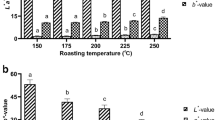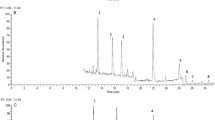Abstract
The N-nitrosopiperidine (NPIP) formation in blends of spices and nitrite curing salt was investigated in relation with the piperine and piperidine contents in spices. Firstly, two analytical methods were developed. Piperine was extracted with dichloromethane by means of accelerated solvent extraction (ASE) and determined by high-performance liquid chromatography (HPLC)–diode array detector (λ = 343 nm). A selective hydroextraction of piperidine using ASE and its quantification by HPLC–ELSD was applied. Both methods were sufficiently sensitive and accurate (limit of detection, limit of quantification, and recovery: 0.28, 0.84 μg, and 98.9 ± 2.6 % for piperine, and 5.76, 17.45 μg, and 95.9 ± 2.9 % for piperidine, respectively). Secondly, both compounds were quantified in commercial samples (black and white pepper, paprika, chili pepper, allspice, and nutmeg). The maximum amount of piperine (21.12 mg g−1) was found in pepper, while the other spices contained only traces. Piperidine was detected mainly in the pepper samples, whereby the highest concentration was found in the white pepper extract (11.42 mg g−1). Thirdly, during the storage of spices blended with nitrite curing salt, the NPIP content was determined, using a gas chromatograph coupled with a thermal energy analyzer. Against our expectations, no NPIP formation was observed in the curing mixture which contained white pepper extract. This result remains in contrast with the white pepper mixture, in which the NPIP content significantly increased from not detected to 9.80 ± 0.41 ng g−1 after the 2 months storage period. In conclusion, high amounts of piperine or piperidine in spices do not systematically result in the formation of NPIP, when blended with nitrite curing salt .



Similar content being viewed by others
References
Prabhakaran Nair KP (2004) The agronomy and economy of black pepper (Piper nigrum L.)—the “king of spices”. ICFAI University Press, Hyderabad
Verzele M, Van Damme F, Schuddinck G, Vyncke P (1989) Quantitative microscale liquid chromatography of piperine in pepper and pepper extracts. J Chromatogr 471:335–346
Saikh J, Bhosale R, Singhal R (2006) Microencapsulation of black pepper oleoresins. Food Chem 94(1):105–110
Shenoy NR, Choughuley AS (1992) Characterization of potentially mutagenic products from the nitrosation of piperine. Cancer Lett 64(3):235–239
De Mey E, De Maere H, Goemaere O, Steen L, Peeters M-C, Derdelinckx G, Fraeye I (2013) Evaluation of N-nitrosopiperidine formation from biogenic amines during the production of dry fermented sausages. Food Bioprocess Technol. doi:10.1007/s11947-013-1125-5
Drabik-Markiewicz, G., De Mey, E., Impens, S., Kowalska, T., Vander Heyden, Y., Paelinck, H. (2010) Role of cadaverine and piperidine in the formation of N-nitrosopiperidine in heated cured meat. Proc 56th ICOMST, Jeju, Korea
Verzele M, De Cleyn R (1972) Constituents of Peppers I. Qualitative analysis of piperine isomers. Chromatographia 5:346–350
Reshmi SK, Sathya ES (2010) Isolation of piperdine from Piper nigrum and its antiproliferative activity. J Pharm Res 3(10):2502–2507
Subramanian R, Subbramaniyan P, Noorul Ameen J, Raj V (2011) Double bypasses soxhlet apparatus for extraction of piperine from Piper nigrum. Arabian J Chem. doi:10.1016/j.arabjc.2011.06.022
Kanaki N, Dave M, Padh H, Rajani M (2008) A rapid method for isolation of piperine from the fruits of Piper nigrum Linn. J Nat Med 62(3):281–283
Raman G, Gaikar V (2002) Microwave-Assisted extraction of piperine from piper nigrum. Ind Eng Chem Res 41:2521–2528
Cao X, Ye X, Lu Y, Yu Y, Mo W (2009) Ionic liquid-based ultrasonic-assisted extraction of piperine from white pepper. Anal Chim Acta 640(1–2):47–51
Rajopadhye AA, Namjoshi TP, Upadhye AS (2012) Rapid validated HPTLC method for estimation of piperine and piperlongumine in root of Piper longum extract and its commercial formulation. Braz J Pharmacogn 22(6):1355–1361
Stöhr JR, Xiao PG, Bauer R (2001) Constituents of Chinese Piper species and their inhibitory activity on prostaglandin and leukotriene biosynthesis in vitro. J Ethnopharmacol 75(2–3):133–139
Suresh D, Manjunatha H, Srinivasan K (2007) Effect of heat processing of spices on the concentrations of their bioactive principles: turmeric (Curcuma longa), red pepper (Capsicum annuum) and black pepper (Piper nigrum). J Food Compos Anal 20(3–4):346–351
Kozukue N, Park M-S, Choi S-H, Lee S-U, Ohnishi-Kameyama M, Levin CE, Friedman M (2007) Kinetics of light-induced cis-trans isomerization of four piperines and their levels in ground black peppers as determined by HPLC and LC/MS. J Agr Food Chem 55(17):7131–7139
Obata Y, Ishikawa Y, Kitazawa R (1960) Studies on the components of the Hemp Plant (Cannabis sativa L.) Part II. Isolation and identification of piperidine and several amino acids in the hemp plant. Bull Agr Chem Soc Japan 24(7):670–672
Saarinen M (2002) Determination of Biogenic Amines as Dansyl Derivatives in Intestinal Digesta and Feces by Reversed Phase HPLC. Chromatographia 55:297–300
Hayakawa K, Imaizumi N, Ishikura H, Minogawa E, Takayama N, Kobayashi H, Miyazaki M (1990) Determination of methamphetamine, amphetamine and piperidine in human urine by high-performance liquid chromatography with chemiluminescence detection. J Chromatogr 515:459–466
Drabik-Markiewicz G, Dejaegher B, De Mey E, Kowalska T, Paelinck H, Vander Heyden Y (2011) Influence of putrescine, cadaverine, spermidine or spermine on the formation of N-nitrosamine in heated cured pork meat. Food Chem 126(4):1539–1545
Schulz H, Baranska M, Quilitzsch R, Schütze W, Lösing G (2005) Characterization of peppercorn, pepper oil, and pepper oleoresin by vibrational spectroscopy methods. J Agr Food Chem 53(9):3358–3363
Liu, H., Zeng, F. K., Wang, Q. H., Wu, H. S., Tan, L. H. (2013) Studies on the chemical and flavor qualities of white pepper (Piper nigrum L.) derived from five new genotypes. Eur Food Res Technol. Doi:10.1007/s00217-013-1986-x
Nisha P, Singhal RS, Pandit AB (2009) The degradation kinetics of flavor in black pepper (Piper nigrum L.). J Food Eng 92(1):44–49
Sen NP, Donaldson B, Charbonneau C, Miles WF (1974) Effect of additives on the formation of nitrosamines in meat curing mixtures containing spices and nitrite. J Agr Food Chem 22(6):1125–1130
Gough T, Goodhead K (1975) Occurrence of volatile nitrosamines in spice premixes. J Sci Food Agric 26:1473–1478
Code of Federal Regulation, Title 21 Food and Drugs (2012) US Food and Drug administration. http://www.accessdata.fda.gov. Accessed 6 June 2013
Wang Y, Jiang Z, Li R (2013) Composition Comparison of Essential Oils Extracted by Hydrodistillation and Microwave-assisted Hydrodistillation from Black Pepper (Piper nigrum L.) Grown in China. J Essent Oil Bear Plants 12(3):374–380
Tsai P-J, Tsai T-H, Yu C-H, Ho S-C (2007) Evaluation of NO-suppressing activity of several Mediterranean culinary spices. Food Chem Toxicol 45(3):440–447
Baliga MS, Jagetia GC, Rao SK, Babu K (2003) Evaluation of nitric oxide scavenging activity of certain spices in vitro: a preliminary study. Food/Nahr 47(4):261–264
Yanishlieva NV, Marinova E, Pokorný J (2006) Natural antioxidants from herbs and spices. Eur J Lipid Sci Technol 108(9):776–793
Li L, Shao J, Zhu X, Zhou G, Xu X (2013) Effect of plant polyphenols and ascorbic acid on lipid oxidation, residual nitrite and N-nitrosamines formation in dry-cured sausage. Int J Food Sci Technol 48:1116–1157
Acknowledgments
This work was performed in the framework of the MeCagrO2 project “Safe products, sustainable processes and employment increased attractiveness for companies from the 2 Seas agro food Area”. Note: “The document reflects the authors’ views. The interreg IVA 2 Seas Programme Authorities are not liable for any use that may be made of the information contained therein.”
Conflict of interest
None.
Compliance with Ethics Requirements
This article does not contain any studies with human or animal subjects.
Author information
Authors and Affiliations
Corresponding author
Rights and permissions
About this article
Cite this article
De Mey, E., De Maere, H., Dewulf, L. et al. Assessment of the N-nitrosopiperidine formation risk from piperine and piperidine contained in spices used as meat product additives. Eur Food Res Technol 238, 477–484 (2014). https://doi.org/10.1007/s00217-013-2125-4
Received:
Revised:
Accepted:
Published:
Issue Date:
DOI: https://doi.org/10.1007/s00217-013-2125-4




